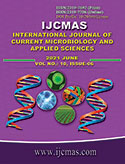


 National Academy of Agricultural Sciences (NAAS)
National Academy of Agricultural Sciences (NAAS)

|
PRINT ISSN : 2319-7692
Online ISSN : 2319-7706 Issues : 12 per year Publisher : Excellent Publishers Email : editorijcmas@gmail.com / submit@ijcmas.com Editor-in-chief: Dr.M.Prakash Index Copernicus ICV 2018: 95.39 NAAS RATING 2020: 5.38 |
Diseases severely affect crop yield and quality, thereby threatening global food security. Genetic improvement of plant disease resistance is essential for sustainable agriculture. For this, new biotechnological techniques such as, RNA Interference, Gene Silencing, Gene Editing are gaining worldwide attention for disease resistance programs. Among these, Gene Editing (GE) using site-directed nucleases (SDNs) is an important and potential technique that overcomes limitations associated with classical breeding and transgenesis as Gene editing (GE) is an effective tool for modifying a target genome to create novel phenotypes in plants (Mao et al., 2019). GE technology can produce precise, efficient, and targeted mutations from a single nucleotide to broad sequence deletions, rearrangements, and integrations (Curtin et al., 2012). Modern genome editing (GE) techniques, which include clustered regularly interspaced short palindromic repeat (CRISPR)/CRISPR-associated protein 9 (CRISPR/Cas9) system, transcription activator-like effector nucleases (TALENs), zinc-finger nucleases (ZFNs) and homing endonucleases (meganucleases), have so far been used for engineering disease resistance in crops. The use of GE technologies has grown very rapidly in recent years with numerous examples of targeted mutagenesis in crop plants, including gene knockouts, knockdowns, modifications, and the repression and activation of target genes. CRISPR/Cas9 supersedes all other GE techniques including TALENs and ZFNs for editing genes owing to its unprecedented efficiency, relative simplicity and low risk of off-target effects. Broad-spectrum disease resistance has been engineered in crops by GE of either specific host-susceptibility genes (S gene approach), or cleaving DNA of phytopathogens (bacteria, virus or fungi) to inhibit their proliferation. Thus, GE techniques can potentially be used to boost immunity and resistance against different phytopathogens in crops, ultimately leading to the development of promising disease-resistant crop varieties.
 |
 |
 |
 |
 |